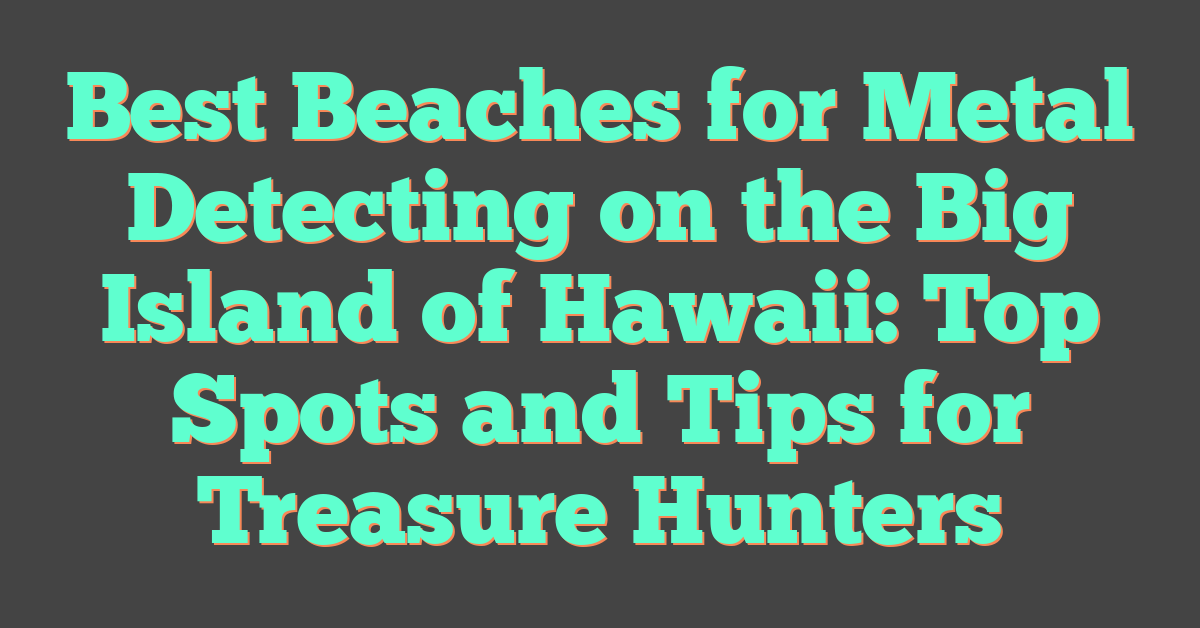I love spending time outdoors, and metal detecting is one of my favorite hobbies.

The Big Island of Hawaii has many beautiful beaches that are perfect for people looking to discover hidden items.

If you want to search for coins, jewelry, or small treasures, some beaches on the Big Island work better for metal detecting than others.
I’m excited to share what I know about finding the right spots on the island that make this hobby even more fun.
Ho‘okena Beach Park
I had a great time exploring Ho‘okena Beach Park.
The beach has soft, gray sand and a gentle mix of coral pieces.
It’s not as crowded as some other beaches, so it felt peaceful when I walked along the shore looking for hidden treasures.
I watched local fishermen launch their canoes right from the beach.
They carry on the old Hawaiian canoe fishing traditions.
Seeing the old steamship pier remains and the scattered canoes gave me a sense of history here.
The reef near the shore creates calm, clear water on most days.
This makes scanning the sand easier.
When the waves get bigger, people boogie board and have fun.
It’s a popular spot to snorkel or rent a kayak.
You can always find space for metal detecting in the early morning.
Camping is allowed, and staying overnight gave me a chance to watch a stunning sunset and get an early start.
The sound of the waves at night made the trip relaxing.
The early morning light helped me spot interesting objects washed up above the high tide line.
Rating: 4.6 (1311 reviews)
Location: Ho‘okena Beach Park, Captain Cook, HI
Contact: (808) 328-8450
Website: Visit Website
Onekahakaha Beach Park
When I got to Onekahakaha Beach Park in Hilo, I noticed right away how family-friendly it felt.
There are calm wading pools that are great for kids and for anyone who likes to relax in shallow water.
I saw lots of people picnicking under the park’s shelters and using the play equipment.
The shoreline here is rocky in places, but there’s plenty of sand, too.
Metal detecting was easy because the beach isn’t too crowded, especially on weekday mornings.
I found a few coins and a ring near the picnic areas, so people sometimes drop items without realizing it.
The tidal pools are separated from the rougher ocean waves, which made it safe to search along the edges.
The water is clear, so it’s easy to spot anything shiny if it turns up before you even dig.
It’s also a peaceful spot if you just want to take a break and enjoy the scenery.
Rating: 4.7 (1473 reviews)
Location: 74 Onekahakaha Rd, Hilo, HI 96720
Contact: (808) 961-8311
Website: Visit Website
Essential Tips for Beach Metal Detecting

When I set out to metal detect on the Big Island’s beaches, I always keep a few key points in mind.
Knowing the rules, respecting the environment, and picking the right times help make my experience smooth and fun.
Permits and Local Regulations
Before I bring out my detector, I check for any local rules or permits that I might need.
Most public beaches on the Big Island allow metal detecting, but some private or protected areas have restrictions.
I read beach signs and look for posted regulations, especially near resorts or parks.
State parks often have different rules than regular public beaches.
If I’m unsure, I contact the Hawaii Department of Land and Natural Resources.
It’s best to get clear information instead of risking a fine or being asked to leave.
Certain historic or cultural sites do not allow metal detecting.
I check with local communities or online forums if I have questions about specific locations.
Responsible Metal Detecting Practices
When I dig on the beach, I use small tools and carry a pouch for any trash or items I find.
I always fill in any holes I dig so the sand stays smooth for others.
This keeps the beach safe for playing and walking.
I avoid disturbing plants, wildlife, and other beachgoers.
If I find something valuable, like a ring or a watch, I try to see if someone has reported it lost.
Returning important items means a lot to people, and it’s a good way to build trust.
I also remove sharp items, such as nails or shards, from the sand.
This helps keep the beach cleaner for everyone.
You can find more tips in these beach metal detecting guidelines.
Choosing the Right Time of Day
I like to go early in the morning or late in the afternoon when the beach is less crowded.
It’s cooler, and I can move around more freely.
During these times, it’s much easier to search near high-traffic areas like entry points, towels, and lifeguard stations.
These spots are where people usually drop things.
Tide matters, too.
I check tide charts and aim for low tide because more beach is exposed and items lost in wet sand become easier to find.
After storms or big waves, I often find new things washed up or uncovered.
For beginners, starting on dry sand is simpler than searching in the wet zone, which can need special detector settings.
If there are any special events like beach parties, I wait a day or two after, because there’s often a better chance of finding interesting items in those areas.
What to Bring for Successful Metal Detecting

Bringing the right gear can make my day at the beach much easier and a lot more fun.
I always focus on tools that help me find and recover things quickly, plus items to keep myself safe and comfortable in the Hawaii sun.
Recommended Equipment
I never go metal detecting without a reliable metal detector that can handle saltwater and sand.
Features like ground balance and waterproof coils are important for beach use.
I’ve found that a sand scoop with a long handle makes digging much easier, especially on hot days.
For smaller finds, I bring a handheld pinpointer.
This tool saves me a lot of time because it helps me locate items buried in the sand.
A sturdy finds pouch or bag is handy for keeping my treasures and trash separate as I go.
Here’s a quick checklist:
| Item | Why I Bring It |
|---|---|
| Metal detector | To find coins and jewelry |
| Sand scoop | Makes digging in sand quick and easy |
| Pinpointer | Locates small items in tight spots |
| Finds pouch/bag | Stores finds and keeps trash separate |
| Gloves | Protects my hands from sharp objects |
If you want more tips on tools people bring to the beach, check out what others use in the metal detecting community.
Sun Protection and Safety Gear
Hawaii’s sun can be intense, so I always plan ahead.
I wear a wide-brimmed hat and lightweight long sleeves to protect myself from sunburn.
I use sunglasses for extra protection.
I apply high SPF sunscreen and reapply it throughout the day, especially after sweating or swimming.
I choose comfortable sandals or water shoes to keep my feet safe from sharp shells and hidden glass.
I also bring plenty of water in a reusable bottle to stay hydrated.
I carry a basic first aid kit for small cuts or scrapes, just in case.






